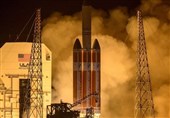Detailed Images Show Sun’s Turbulent Surface
TEHRAN (Tasnim) – The surface of our sun is a wild, violent place and now we can see it in exquisite detail, thanks to the first images returned by the US National Science Foundation's Daniel K. Inouye Solar Telescope based in Hawaii.
The ground-based telescope will work with NASA's Parker Solar Probe, which is orbiting the sun, and the upcoming European Space Agency/NASA Solar Orbiter to help us learn more about the sun and how the space weather it creates could affect Earth.
Details in the newly released images show plasma, which covers the sun, that appears to boil. Giant, Texas-sized cells help create convection, where heat from inside the sun is drawn up to the surface while other cells cool and sink beneath it.
"Since NSF began work on this ground-based telescope, we have eagerly awaited the first images," said France Córdova, National Science Foundation director. "We can now share these images and videos, which are the most detailed of our Sun to date. NSF's Inouye Solar Telescope will be able to map the magnetic fields within the Sun's corona, where solar eruptions occur that can impact life on Earth. This telescope will improve our understanding of what drives space weather and ultimately help forecasters better predict solar storms."
Solar wind streams out from the sun, flinging energetic particles across the solar system. And the sun's corona, the outer atmosphere of the star, is much hotter than the actual surface. The corona is one million degrees Kelvin, while the surface is around 6,000 Kelvin.
Understanding the solar wind and the blazing heat of the corona are key. They both play a role in space weather and solar storms, and understanding the solar wind could enable better prediction of space weather. Solar wind and the corona's temperature also impact ejections of mass from the corona, which could impact the global power grid and telecommunications on Earth, as well as our astronauts on the International Space Station. The energized and accelerated particles streaming away from the sun in the solar wind are also responsible for the northern and southern lights we see on Earth.
But space weather is hard to predict, something scientists are hoping to change with this trio of sun-focused missions and telescopes.
A new analysis published Wednesday in the journal Geophysical Research Letters revealed that severe space super-storms, which are large enough to disrupt our electronic systems and networks, happen once every 25 years. The researchers cited a storm in 1989 that caused a major power blackout in Quebec. And we had a near-miss in 2012 because a storm heading for Earth from the sun changed direction. Had it hit us, it would have caused a super-storm.
"On Earth, we can predict if it is going to rain pretty much anywhere in the world very accurately, and space weather just isn't there yet," said Matt Mountain, president of the Association of Universities for Research in Astronomy, which manages the Inouye Solar Telescope. "Our predictions lag behind terrestrial weather by 50 years, if not more. What we need is to grasp the underlying physics behind space weather, and this starts at the Sun, which is what the Inouye Solar Telescope will study over the next decades."
The sun's magnetic field and plasma also experience entanglement, which can release solar storms that temporarily impact our power grid. The Inouye Solar Telescope has the capability to measure the magnetic field with more detail, leading to a greater understanding of solar activity.
"It's all about the magnetic field," said Thomas Rimmele, director of the Inouye Solar Telescope. "To unravel the Sun's biggest mysteries, we have to not only be able to clearly see these tiny structures from 93 million miles away but very precisely measure their magnetic field strength and direction near the surface and trace the field as it extends out into the million-degree corona, the outer atmosphere of the Sun."
Currently, the early warning for space weather is about 48 minutes, but they want to expand that to 48 hours eventually, according to a release by the National Science Foundation. NOAA also cited that space weather affected radio communications for eight hours during Hurricane Irma as the storm made landfall.
The telescope has a 13-foot mirror, making it the largest for a solar telescope. It also has a cooling system that can provide heat protection for the telescope and a dome to stabilize temperature. Its optics also reduce the blurring effect of Earth's atmosphere.
"These first images are just the beginning," said David Boboltz, program director in NSF's division of astronomical sciences and who oversees the facility's construction and operations. "Over the next six months, the Inouye telescope's team of scientists, engineers and technicians will continue testing and commissioning the telescope to make it ready for use by the international solar scientific community. The Inouye Solar Telescope will collect more information about our Sun during the first five years of its lifetime than all the solar data gathered since Galileo first pointed a telescope at the Sun in 1612."
The telescope, originally known as the Advanced Technology Solar Telescope, was renamed in honor of the late Senator Daniel Inouye in December 2013. It sits on Haleakala, the East Maui volcano. The National Science Foundation said Inouye was a great proponent of STEM and how it could enrich those in Hawaii.
"The astronomical community is honored to have the opportunity to conduct astronomical research on Haleakala on the Island of Maui in Hawai'i," according to a release by the National Science Foundation. "NSF recognizes and acknowledges the very significant cultural role and reverence that this site has to the Native Hawaiian community."






